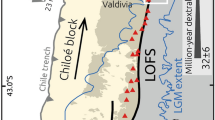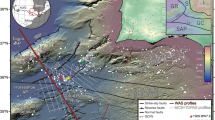Abstract
The collision between India and Asia has been simulated with a variety of computational models that describe or predict the motions of the main faults of east Asia. Geological slip-rate estimates of 20–30 mm yr-1 suggest that the largest of these faults, the 2,000-km-long Altyn Tagh fault system on the northern edge of the Tibetan plateau, absorbs as much of the Indo-Asian convergence signal as do the Himalayas1,2—partly by oblique slip and partly by contraction and mountain growth3,4,5. However, the predictions of dynamic models for Asian deformation6 and the lower bounds of some geological slip-rates estimates (3–9 mm yr-1; refs 7, 8) suggest that the Altyn Tagh system is less active. Here, we report geodetic data from 89–91° E that indicate left-lateral shear of 9 ± 5 mm yr-1 and contraction of 3 ± 1 mm yr-1 across the Altyn Tagh system. This result—combined with our finding that, at 90° E, Tibet contracts north–south at 9 ± 1 mm yr-1—supports the predictions of dynamic models of Asian deformation.
This is a preview of subscription content, access via your institution
Access options
Subscribe to this journal
Receive 51 print issues and online access
$199.00 per year
only $3.90 per issue
Buy this article
- Purchase on Springer Link
- Instant access to full article PDF
Prices may be subject to local taxes which are calculated during checkout





Similar content being viewed by others
References
Molnar, P. & Tapponnier, P. Cenozoic tectonics of Asia: Effects of a continental collision. Science 189, 419–426 (1975).
Molnar, P. & Deng, Q. Faulting associated with large earthquakes and the average rate of deformation in central and eastern Asia. J. Geophys. Res. 89, 6203–6228 (1984).
Peltzer, G., Tapponier, P. & Armijo, R. Magnitude of Late Quaternary left-lateral displacements along the north edge of Tibet. Science 246, 1285–1289 (1989).
Avouac, J-P. & Tapponier, P. Kinematic model of active deformation in central Asia. Geophys. Res. Lett. 20, 895–898 (1993).
Meriaux, A. et al. Large-scale strain patterns, great earthquakes, and late Pleistocene slip-rate along the Altyn Tagh fault (China). Eos (Fall Meet. Suppl.) 79, 400 (1998).
Houseman, G. & England, P. Finite strain calculations of continental collision. 1. Methods and general results for convergent zones. J. Geophys. Res. 91, 3651–3663 (1986).
Altyn Tagh Fault 1– 353 (Special Publication, Seismological Bureau of China, Beijing, 1992). (In Chinese.)
Meyer, B. et al. Rate of left-lateral movement along the easternmost segment of the Altyn Tagh Fault, east of 96° E China. Geophys. J. Int. 124, 29–44 ( 1996).
Lamb, S. A simple method for estimating the horizontal velocity field in wide zones of active deformation—II. Examples from New Zealand, Central Asia and Chile. Geophys. J. Int. 119, 313– 377 (1994).
Peltzer, G. & Saucier, F. Present-day kinematics of Asia derived from geologic fault rates. J. Geophys. Res. 101, 27943–27956 (1996).
Vilotte, J., Daignieres, M. & Madariaga, R. Numerical modeling of intraplate deformation: simple mechanical models of continental collision. J. Geophys. Res. 87, 10709–10728 (1982).
Kong, X. & Bird, P. in Tectonic Evolution of Asia (eds Yin, A. & Harrison, T. M.) 18–34 (Cambridge Univ. Press, 1996).
Houseman, G. & England, P. Crustal thickening versus lateral expulsion of Tibet. J. Geophys. Res. 98, 12233–12249 (1993).
England, P. & Molnar, P. Active deformation of Asia: from kinematics to dynamics. Science 278, 647 –650 (1997).
Jackson, M. & Bilham, R. Constraints on himalayan deformation inferred from vertical velocity fields in Nepal and Tibet. J. Geophys. Res. 99, 13897–13912 ( 1994).
Larson, K., Freymueller, J. & Philipsen, S. Global plate velocities from the Global Positioning System. J. Geophys. Res. 102, 9961– 9982 (1997).
Savage, J. Displacement field for an edge dislocation in a layered half-space. J. Geophys. Res. 103, 2439–2446 (1998).
McCaffrey, R. in Tectonic Evolution of Southeast Asia (eds Hall, R. & Blundell, D. J.) Vol. 106, 3–18 (Geol. Soc. Lond. Spec. Pub., 1996).
Jones, C. & Wesnousky, S. Variations in strength and slip rate along the San Andreas fault system. Science 256 , 83–86 (1992).
King, R. W. et al. Geodetic measurement of crustal motion in southwest China. Geology 25, 179–182 (1997).
Larson, K., Bürgmann, R., Bilham, R. & Freymueller, J. Kinetics of the India-Eurasia collision zone from GPS measurements. J. Geophys. Res. 104, 1111–1130 (1999).
Bilham, R., Larson, K., Freymueller, J. & Project Idylhim members. GPS measurements of present-day convergence across the Nepal Himalaya. Nature 386, 61–64 (1997).
Abdrakhmatov, K. et al. Relatively recent construction of the Tien Shan inferred from GPS measurements of present-day crustal deformation rates. Nature 384, 450–453 ( 1996).
Longjun, Y. & Liou, J. G. Two stage evolution model for the Altyn Tagh fault, China. Geology 27, 227 –230 (1999).
England, P. & Molnar, P. Right-lateral shear and rotation as the explanation for strike slip faulting in Eastern Tibet. Nature 344, 140–142 ( 1990).
Bilham, R., Blume, F., Bendick, R. & Gaur, V. Geodetic constraints on the translation and deformation of India: Implications for future great Himalayan earthquakes. Curr. Sci. 74, 213 –229 (1998).
Acknowledgements
The investigations were funded by the National Science Foundation. G. Pelzer participated in the 1994 survey and we thank him and G. King, P. Tapponnier, P. England, and P. Molnar for discussions of the Asian collision process. R.B. received a John Simon Guggenheim Memorial Foundation fellowship while at Oxford University.
Author information
Authors and Affiliations
Corresponding author
Rights and permissions
About this article
Cite this article
Bendick, R., Bilham, R., Freymueller, J. et al. Geodetic evidence for a low slip rate in the Altyn Tagh fault system . Nature 404, 69–72 (2000). https://doi.org/10.1038/35003555
Received:
Accepted:
Issue Date:
DOI: https://doi.org/10.1038/35003555
This article is cited by
-
Probabilistic Seismic Hazard Analysis of Hazara Kashmir Syntaxes and its Surrounding
Journal of the Geological Society of India (2022)
-
Variations in Locking Along the East Kunlun Fault, Tibetan Plateau, China, Using GPS and Leveling Data
Pure and Applied Geophysics (2020)
-
Temporal and spatial movement characteristics of the Altyn Tagh fault inferred from 21 years of InSAR observations
Journal of Geodesy (2019)
-
First Discovery of North-South Striking Normal Faults near the Potential Eastern End of Altyn Tagh Fault
Journal of Earth Science (2018)
-
Constraints on mountain building in the northeastern Tibet: Detrital zircon records from synorogenic deposits in the Yumen Basin
Scientific Reports (2016)
Comments
By submitting a comment you agree to abide by our Terms and Community Guidelines. If you find something abusive or that does not comply with our terms or guidelines please flag it as inappropriate.



